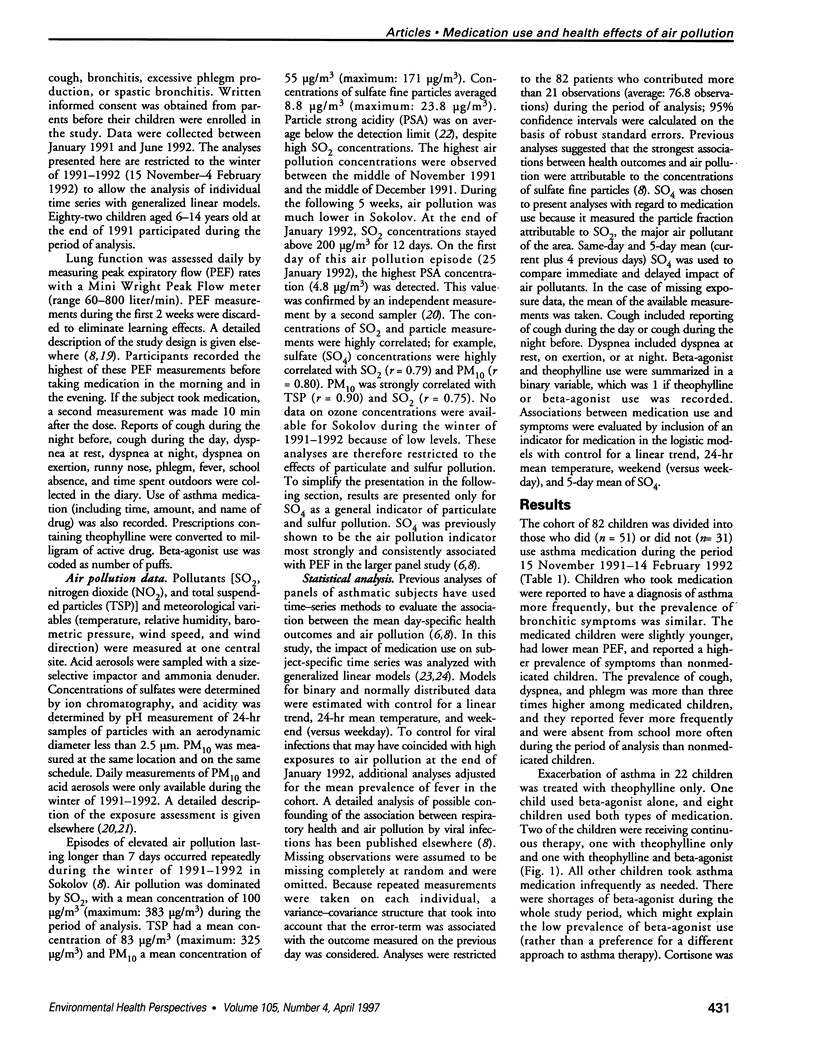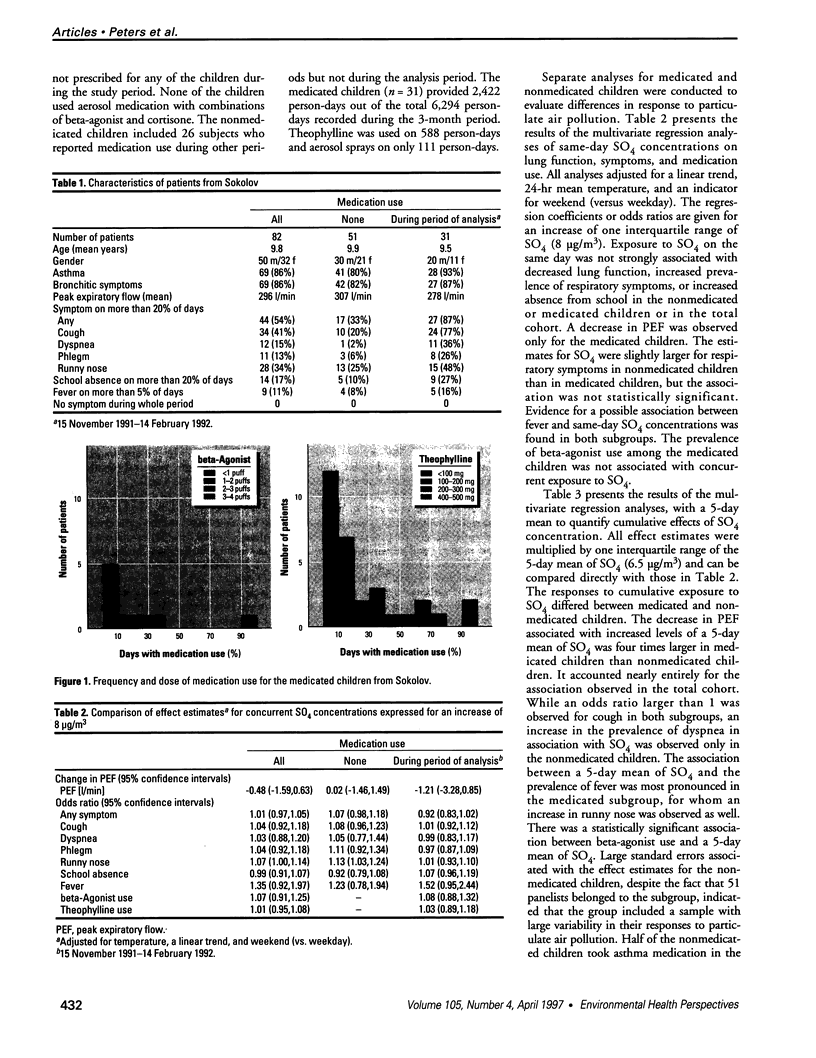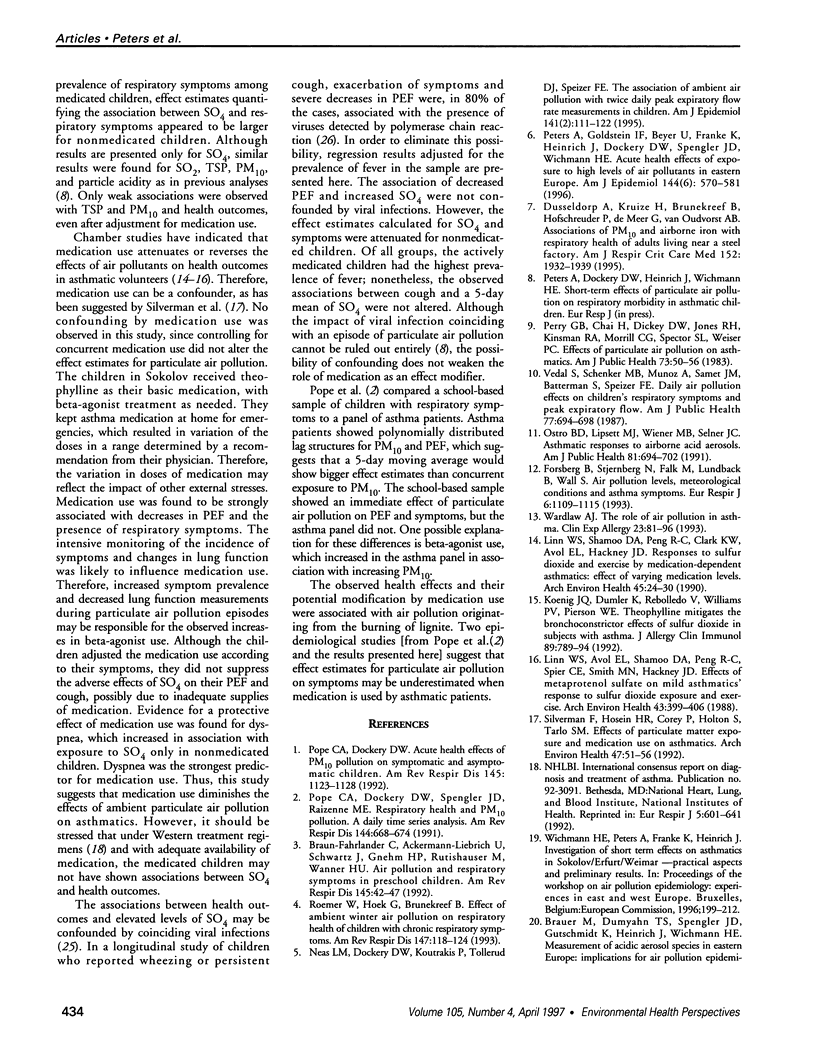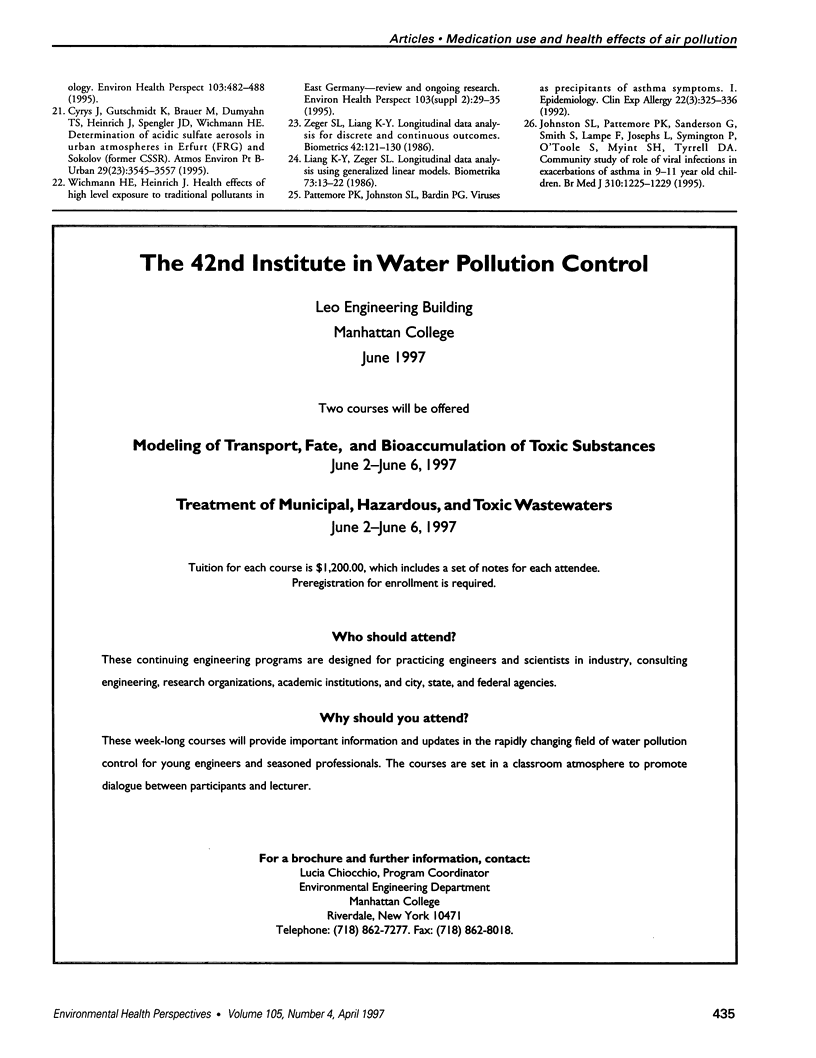Abstract
Previous controlled studies have indicated that asthma medication modifies the adverse effects of sulfur dioxide (SO2) on lung function and asthma symptoms. The present report analyzed the role of medication use in a panel study of children with mild asthma. Children from Sokolov (n = 82) recorded daily peak expiratory flow (PEF) measurements, symptoms, and medication use in a diary. Linear and logistic regression analyses estimated the impact of concentrations of sulfate particles with diameters less than 2.5 microns, adjusting for linear trend, mean temperature, weekend (versus weekday), and prevalence of fever in the sample. Fifty-one children took no asthma medication, and only 31 were current medication users. Most children were treated with theophylline; only nine used sprays containing beta-agonist. For the nonmedicated children, weak associations between a 5-day mean of sulfates and respiratory symptoms were observed. Medicated children, in contrast, increased their beta-agonist use in direct association with an increase in 5-day mean of sulfates, but medication use did not prevent decreases in PEF and increases in the prevalence of cough attributable to particulate air pollution. Medication use was not a confounder but attenuated the associations between particulate air pollution and health outcomes.
Full text
PDF





Images in this article
Selected References
These references are in PubMed. This may not be the complete list of references from this article.
- April M. M., Brodsky L. S., Cunningham M. J., Harari P. M., Harrison L., Poje C. P. Mucoepidermoid carcinoma in a 10-year-old girl. Head Neck. 1997 Aug;19(5):431–435. doi: 10.1002/(sici)1097-0347(199708)19:5<431::aid-hed11>3.0.co;2-a. [DOI] [PubMed] [Google Scholar]
- Braun-Fahrländer C., Ackermann-Liebrich U., Schwartz J., Gnehm H. P., Rutishauser M., Wanner H. U. Air pollution and respiratory symptoms in preschool children. Am Rev Respir Dis. 1992 Jan;145(1):42–47. doi: 10.1164/ajrccm/145.1.42. [DOI] [PubMed] [Google Scholar]
- Dusseldorp A., Kruize H., Brunekreef B., Hofschreuder P., de Meer G., van Oudvorst A. B. Associations of PM10 and airborne iron with respiratory health of adults living near a steel factory. Am J Respir Crit Care Med. 1995 Dec;152(6 Pt 1):1932–1939. doi: 10.1164/ajrccm.152.6.8520758. [DOI] [PubMed] [Google Scholar]
- Forsberg B., Stjernberg N., Falk M., Lundbäck B., Wall S. Air pollution levels, meteorological conditions and asthma symptoms. Eur Respir J. 1993 Sep;6(8):1109–1115. [PubMed] [Google Scholar]
- Johnston S. L., Pattemore P. K., Sanderson G., Smith S., Lampe F., Josephs L., Symington P., O'Toole S., Myint S. H., Tyrrell D. A. Community study of role of viral infections in exacerbations of asthma in 9-11 year old children. BMJ. 1995 May 13;310(6989):1225–1229. doi: 10.1136/bmj.310.6989.1225. [DOI] [PMC free article] [PubMed] [Google Scholar]
- Koenig J. Q., Dumler K., Rebolledo V., Williams P. V., Pierson W. E. Theophylline mitigates the bronchoconstrictor effects of sulfur dioxide in subjects with asthma. J Allergy Clin Immunol. 1992 Apr;89(4):789–794. doi: 10.1016/0091-6749(92)90432-2. [DOI] [PubMed] [Google Scholar]
- Linn W. S., Avol E. L., Shamoo D. A., Peng R. C., Spier C. E., Smith M. N., Hackney J. D. Effect of metaproterenol sulfate on mild asthmatics' response to sulfur dioxide exposure and exercise. Arch Environ Health. 1988 Nov-Dec;43(6):399–406. doi: 10.1080/00039896.1988.9935858. [DOI] [PubMed] [Google Scholar]
- Linn W. S., Shamoo D. A., Peng R. C., Clark K. W., Avol E. L., Hackney J. D. Responses to sulfur dioxide and exercise by medication-dependent asthmatics: effect of varying medication levels. Arch Environ Health. 1990 Jan-Feb;45(1):24–30. doi: 10.1080/00039896.1990.9935920. [DOI] [PubMed] [Google Scholar]
- Neas L. M., Dockery D. W., Koutrakis P., Tollerud D. J., Speizer F. E. The association of ambient air pollution with twice daily peak expiratory flow rate measurements in children. Am J Epidemiol. 1995 Jan 15;141(2):111–122. doi: 10.1093/oxfordjournals.aje.a117399. [DOI] [PubMed] [Google Scholar]
- Ostro B. D., Lipsett M. J., Wiener M. B., Selner J. C. Asthmatic responses to airborne acid aerosols. Am J Public Health. 1991 Jun;81(6):694–702. doi: 10.2105/ajph.81.6.694. [DOI] [PMC free article] [PubMed] [Google Scholar]
- Pattemore P. K., Johnston S. L., Bardin P. G. Viruses as precipitants of asthma symptoms. I. Epidemiology. Clin Exp Allergy. 1992 Mar;22(3):325–336. doi: 10.1111/j.1365-2222.1992.tb03094.x. [DOI] [PMC free article] [PubMed] [Google Scholar]
- Perry G. B., Chai H., Dickey D. W., Jones R. H., Kinsman R. A., Morrill C. G., Spector S. L., Weiser P. C. Effects of particulate air pollution on asthmatics. Am J Public Health. 1983 Jan;73(1):50–56. doi: 10.2105/ajph.73.1.50. [DOI] [PMC free article] [PubMed] [Google Scholar]
- Peters A., Goldstein I. F., Beyer U., Franke K., Heinrich J., Dockery D. W., Spengler J. D., Wichmann H. E. Acute health effects of exposure to high levels of air pollution in eastern Europe. Am J Epidemiol. 1996 Sep 15;144(6):570–581. doi: 10.1093/oxfordjournals.aje.a008967. [DOI] [PubMed] [Google Scholar]
- Pope C. A., 3rd, Dockery D. W. Acute health effects of PM10 pollution on symptomatic and asymptomatic children. Am Rev Respir Dis. 1992 May;145(5):1123–1128. doi: 10.1164/ajrccm/145.5.1123. [DOI] [PubMed] [Google Scholar]
- Pope C. A., 3rd, Dockery D. W., Spengler J. D., Raizenne M. E. Respiratory health and PM10 pollution. A daily time series analysis. Am Rev Respir Dis. 1991 Sep;144(3 Pt 1):668–674. doi: 10.1164/ajrccm/144.3_Pt_1.668. [DOI] [PubMed] [Google Scholar]
- Roemer W., Hoek G., Brunekreef B. Effect of ambient winter air pollution on respiratory health of children with chronic respiratory symptoms. Am Rev Respir Dis. 1993 Jan;147(1):118–124. doi: 10.1164/ajrccm/147.1.118. [DOI] [PubMed] [Google Scholar]
- Silverman F., Hosein H. R., Corey P., Holton S., Tarlo S. M. Effects of particulate matter exposure and medication use on asthmatics. Arch Environ Health. 1992 Jan-Feb;47(1):51–56. doi: 10.1080/00039896.1992.9935944. [DOI] [PubMed] [Google Scholar]
- Vedal S., Schenker M. B., Munoz A., Samet J. M., Batterman S., Speizer F. E. Daily air pollution effects on children's respiratory symptoms and peak expiratory flow. Am J Public Health. 1987 Jun;77(6):694–698. doi: 10.2105/ajph.77.6.694. [DOI] [PMC free article] [PubMed] [Google Scholar]
- Wardlaw A. J. The role of air pollution in asthma. Clin Exp Allergy. 1993 Feb;23(2):81–96. doi: 10.1111/j.1365-2222.1993.tb00303.x. [DOI] [PubMed] [Google Scholar]
- Wichmann H. E., Heinrich J. Health effects of high level exposure to traditional pollutants in East Germany--review and ongoing research. Environ Health Perspect. 1995 Mar;103 (Suppl 2):29–35. doi: 10.1289/ehp.95103s229. [DOI] [PMC free article] [PubMed] [Google Scholar]
- Zeger S. L., Liang K. Y. Longitudinal data analysis for discrete and continuous outcomes. Biometrics. 1986 Mar;42(1):121–130. [PubMed] [Google Scholar]






